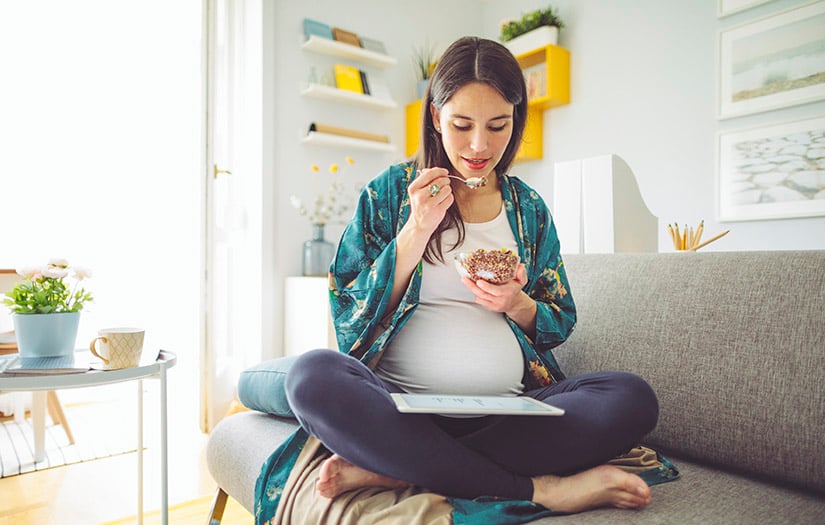In the summer of 2016, I was preparing to give birth to my son and was eager to rejoin my friends at my CrossFit gym. Having kept up a regular prenatal exercise routine throughout my pregnancy, I was confident I would be back to the high-intensity workouts and heavy Olympic lifts I loved in no time. Despite being surrounded by plenty of fit moms who regularly bested me in workouts, we never discussed the postpartum experience. Seeing my friends and favorite celebrities bounce back quickly after giving birth lead me to believe that losing postpartum weight would be a breeze.
Once I gave birth to my son, I realized everything I thought I knew about losing the weight I gained during my pregnancy was wrong.
Here are 10 things I wish someone had told me about losing postpartum weight.
The info in this blog complements the content found within the Women's Fitness Course and the Weight Loss Specialization.
10 Things To Consider About Pregnancy Weight Loss
- Losing the baby weight takes time
- Weight loss begins when the baby is born
- Regardless of weight, you will still look a solid six months pregnant after you give birth
- Your joints may feel differently
- Urinating during exercise is not normal
- Losing weight and the "mom pouch"? Check for Diastasis Recti.
- Breastfeeding may help
- Any exercise counts
- Sleep and weight loss
- There is no "one-site-fits-all" approach to postpartum weight loss
1. Losing the baby weight takes time
The reality is that after taking almost 10 months to grow a baby, it will take time to lose postpartum weight. A recent study found that only 20% of women return to their pre-pregnancy weight within the first three months postpartum and that 24% of women retain at least 10 pounds one year postpartum. (McKinely et al., 2018.)
This means, on average, 80% of women take more than three months to return to their pre-pregnancy weight. I was not a failure because I did not immediately return to my skinny jeans. I was normal! We would all love to lose weight quickly, as the recommended weight loss goal is to lose around 1 pound a week. (Mayo Clinic, 2020)
For a little help, see these progressive post-pregnancy exercises for weight loss.
2. Your initial weight loss will happen when the baby is born.
Your initial weight loss begins when you give birth. The baby, amniotic fluid, placenta, and other fluids leave your body, and over the next six weeks, you will continue to lose weight as other fluids in your body return to pre-pregnancy levels. (Mckinley et al., 2018) I remember getting on the scale shortly after giving birth, and I was down almost 11 pounds!
The average weight loss at birth is 13 pounds. (Mayo Clinic, 2020) After six weeks, it is reasonable to conclude that most of the remaining weight is adipose tissue. (McKinley et al., 2018).
3. Regardless of weight, you will still look a solid six months pregnant after you give birth.
When pregnant, the uterus changes position within your body and grows. The average uterus is about the size of a grapefruit at 12 weeks, and at 40 weeks, the average uterus has grown to the size of a watermelon! (American Pregnancy Association, 2020)
After you give birth, your uterus is still that size and will gradually shrink over the next six weeks. So, despite having your baby swaddled in your arms, you will still need your maternity leggings and look very pregnant.
4. Your joints may feel differently.
A few months after giving birth to my son, I attempted to go for a light jog and immediately experienced knee and ankle pain I had never felt before. More significant amounts of the hormones estrogen and relaxin are released throughout pregnancy to prepare the body for childbirth. (Chu et al., 2019) However, the pelvic joints are not the only joints impacted.
One study found that the knees also experience increased postpartum laxity. (Chu et al., 2019) Laxity is defined as excessive flexibility of the joint. This hypermobility can cause altered gait mechanics when running and walking, leading to joint pain and even feeling a little clumsy.
Take this into consideration when returning to a physical fitness routine. I found I had to give up my beloved zero-drop shoes I had been running in for the previous six years for shoes with more cushion.
5. Urinating during exercise is not normal.
Peeing when you sneeze, jump rope, or laugh is often accepted as a “new normal” for postpartum mothers, but stress urinary incontinence (SUI) can be corrected. (Corton, 2019) Changing hormone levels, plus the stress of carrying and delivering a baby, can cause trauma to the pelvic floor.
If you experience leakage, see your doctor or find a pelvic floor physical therapist to learn how to treat your symptoms. Spoiler alert: The answer is not always more Kegels!
6. Steadily losing weight but still have a “mom pooch?”
Check yourself for diastasis recti. Diastasis recti abdominis, commonly referred to as diastasis recti, is the separation of rectus abdominis on front of the abdomen. (Ncharry, 2015) The rectus abdominis are the primary muscles that make up the coveted “6 pack”. Diastasis recti is relatively common, affecting 66% of women in the third trimester and up to 53% of women postpartum. (Thebet et al., 2019)
In addition to making it difficult to achieve “6 pack abs”, diastasis recti wreaks havoc on the body. Diastasis recti contributes to poor posture, lower back pain, weakens the core, can contribute to pelvic floor dysfunction, and can even impact your ability to breathe correctly (Thebet et al., 2019).
If you notice a bulging or coning-in your abdomen when performing a crunch, refrain from further core exercise and make an appointment with your doctor to check for diastasis recti Michalska et al., 2018).
7. Breastfeeding MAY help.
Theoretically, breastfeeding would help with weight loss as calories are required for breastmilk production; however, there is little evidence to support that breastfeeding impacts postpartum weight loss (Neville et al., 2013). I found that breastfeeding made me ravenous, and I cannot say whether it helped with my postpartum weight loss or not.
8. Any exercise counts.
The day I was cleared to return to exercise by my doctor, I went home and immediately tried to do a burpee. I could not even push myself off the ground! A fitness perfectionist at heart, I was greatly discouraged when I could no longer perform a burpee, much less the complex movements I had mastered. Not only that, but my son cried whenever I put him down. I had a difficult time motivating myself to exercise with these changes.
I was so tired and had no childcare to watch my son, a common barrier to exercise women experience postpartum. (Mckinley et al., 2018) Finally, I discovered my son would snuggle up in a baby carrier, and I could go for walks on the route I used to run. As my son grew, walks turned into light jogs with a jogging stroller, then I would throw in some bodyweight squats and pushups and progressed from there. It all started with accepting that my body had changed, and any sustained movement counted as exercise.
9. The amount of sleep you get can impact weight loss.
Lack of sleep and caring for a newborn go hand in hand, but it turns out that this change in sleep pattern can also affect postpartum weight loss. Averaging less than five hours of sleep a night has been linked to weight gain in women (Xiao et al., 2015). Consistent sleep deprivation can impact the hormones that control appetite, causing tired mothers to feel hungrier than they would feel when well-rested (Xiao et al., 2015).
10. There is no “one size fits all” approach to weight loss.
Everyone is an individual, and while it is easy to compare our postpartum weight loss journey with others, it is important to remember that everyone’s weight loss journey will be different. Mckinley et al. (2018) found that many factors impact postpartum weight loss. From the obvious factors like sleep, nutrition, and exercise, there are psychosocial factors like postpartum depression and anxiety. Demographic and lifestyle factors also have an impact, from access to childcare, partner support, and economic factors.
My expectations for postpartum weight loss with my second child were radically different than the expectations I had with my son. Considering everything I learned I was able to adjust my expectations and approach my second postpartum weight loss journey with grace.
Of course, there were still sleepless nights and slowly working my way into a regular fitness routine, but this time I was able to appreciate the dramatic changes my body had been through and embrace my postpartum weight loss journey.
Sources
A. (2020, September 12). {: en}Uterus Size During Pregnancy - American Pregnancy Association{: es}El Tamaño del Utero Durante el Embarazo{:}. American Pregnancy Association. https://americanpregnancy.org/healthy-pregnancy/pregnancy-health-wellness/uterus-size-during-pregnancy-5539/
Acharry, N., & Kutty, R. K. (2015). ABDOMINAL EXERCISE WITH BRACING, A THERAPEUTIC EFFICACY IN REDUCING DIASTASIS-RECTI AMONG POSTPARTAL FEMALES. International Journal of Physiotherapy and Research, 3(2), 999–1005. https://doi.org/10.16965/ijpr.2015.122
Chu, S. R., Boyer, E. H., Beynnon, B., & Segal, N. A. (2019). Pregnancy Results in Lasting Changes in Knee Joint Laxity. PM&R, 11(2), 117–124. https://doi.org/10.1016/j.pmrj.2018.06.012
Corton, M. (2020, May 19). Tips to prevent involuntary urine leakage (incontinence) during and after pregnancy. Www.Utswmed.Org. https://utswmed.org/medblog/leakage-incontinence-during-after-pregnancy/
Davis, J. N., Shearrer, G. E., Tao, W., Hurston, S. R., & Gunderson, E. P. (2017). Dietary variables associated with substantial postpartum weight retention at 1-year among women with GDM pregnancy. BMC Obesity, 4(1), 0. https://doi.org/10.1186/s40608-017-0166-0
Evenson, K. R., Mottola, M. F., Owe, K. M., Rousham, E. K., & Brown, W. J. (2014). Summary of International Guidelines for Physical Activity After Pregnancy. Obstetrical & Gynecological Survey, 69(7), 407–414. https://doi.org/10.1097/ogx.0000000000000077
McKinley, M. C., Allen-Walker, V., McGirr, C., Rooney, C., & Woodside, J. V. (2018). Weight loss after pregnancy: challenges and opportunities. Nutrition Research Reviews, 31(2), 225–238. https://doi.org/10.1017/s0954422418000070
Michalska, A., Rokita, W., Wolder, D., Pogorzelska, J., & Kaczmarczyk, K. (2018). Diastasis recti abdominis — a review of treatment methods. Ginekologia Polska, 89(2), 97–101. https://doi.org/10.5603/gp.a2018.0016
Mottola, M. F. (2002). Exercise in the Postpartum Period. Current Sports Medicine Reports, 1(6), 362–368. https://doi.org/10.1249/00149619-200212000-00010
Neville, C. E., McKinley, M. C., Holmes, V. A., Spence, D., & Woodside, J. V. (2013). The relationship between breastfeeding and postpartum weight change—a systematic review and critical evaluation. International Journal of Obesity, 38(4), 577–590. https://doi.org/10.1038/ijo.2013.132
Thabet, A. A., & Alshehri, M. A. (2019). Efficacy of deep core stability exercise program in postpartum women with diastasis recti abdominis: a randomized controlled trial. Journal of Musculoskeletal and Neuronal Interactions, 19(1), 62–68. https://www.ncbi.nlm.nih.gov/pmc/articles/PMC6454249/
Weight loss after pregnancy: Reclaiming your body. (2020, July 31). Mayo Clinic. https://www.mayoclinic.org/healthy-lifestyle/labor-and-delivery/in-depth/weight-loss-after-pregnancy/art-20047813
Xiao, R. S., Kroll-Desrosiers, A. R., Goldberg, R. J., Pagoto, S. L., Person, S. D., & Waring, M. E. (2014). The impact of sleep, stress, and depression on postpartum weight retention: A systematic review. Journal of Psychosomatic Research, 77(5), 351–358. https://doi.org/10.1016/j.jpsychores.2014.09.016












